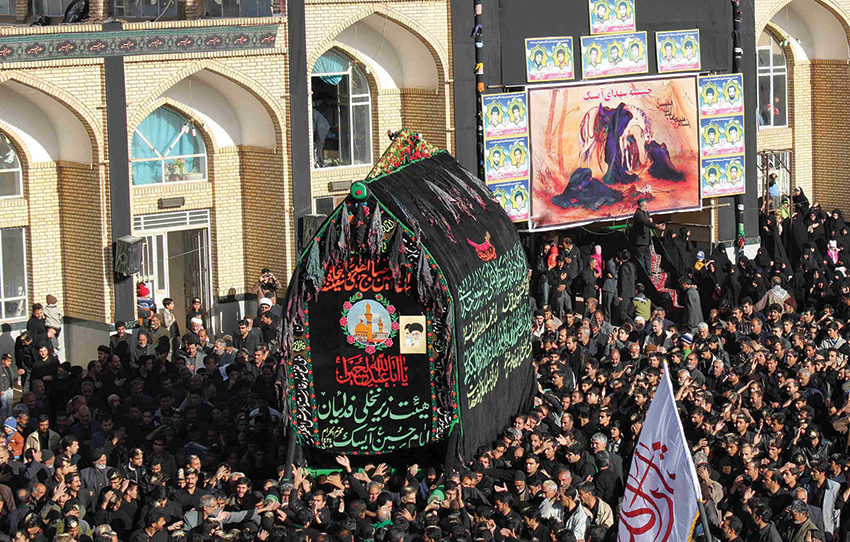Everyone in the procession chants “Ya Hussein”, in loud wails of lamentation.
These form a part of important rituals observed by Shi’a Muslims during the mourning month of Muharram that started Oct 26.
Ashura, marks the tenth day of this month and can be one of the most overcrowded days in Iran. People converge on the streets and march in long processions, beating their chest in mourning to the tune of beating drums, while holding banners and carrying replicas of the mausoleum of Imam Hussein (AS), the grandson of Prophet Muhammad (PBUH) and the third Imam of Shiites who was martyred on this day fourteen hundred years ago.
During Ashura, and its preceding day, Tasua, booths are set up on most streets, offering sweet drinks to passers for free. Households prepare food, known as Nazri, for others as a way of almsgiving. Both the preparing and the partaking of this food are considered a privilege by believers. No one must go hungry or thirsty on this day, the saddest in the Islamic calendar.
During the month, especially on Ashura, people show their sorrow by wearing mourning attire, all in black. In bereavement, the streets too are shrouded with black flags and banners.
People form assemblies during the first ten days of the month and listen to the orators reciting ritualized accounts of the Battle of Karbala, in which Imam Hussein (AS) and his 72 close family members, aides and companions were besieged, deprived of food and water and martyred 1,400 years ago.
These ceremonies are held each year to commemorate the life and death of the fallen. Ashura symbolizes the battle between the good and the evil, the virtue and vice. The tragedy is marked, among other things, to persistently convey the message that being outnumbered does not count when it comes to right against wrong.
In the plains of the Iraqi holy city of Karbala, Imam Hussein and his followers sacrificed all and everything humanly possible for the sake of Islam and Allah, to show that right is might, how the blood of the innocent can win over the sword of tyrants, and how to achieve victory despite being oppressed. Shi’a Muslims believe that even though the great Imam was killed in battle, his message was heard loud and clear by the people of his own time, those who followed and will follow until eternity.
Ashura as the symbol of truth, dignity, honesty, selflessness and human integrity is not limited only to Muslims. Rather, it is respected and commemorated by followers of other faiths in and outside Iran. Mahatma Gandhi, the leader and founder of free India once said, “If India is to succeed as a country, it needs to follow the path of Imam Hussein.”
Special Rituals
Traveling across Iran in Muharram, one witnesses rituals in various forms; from those in northern Iran to the ceremonies in the southern regions. However, those performed in Yazd, as testified by many, is outstanding and deserves special mention.
People in Yazd take their religion and religious occasions rather seriously. Observing people collaborating voluntarily and organizing all the rituals spontaneously during Muharram and the following month of Safar, one intensely feels the religious spirit in towns big and small. The province in central Iran is famous for a special ritual called Nakhl-Gardani (literally means carrying and turning the palm tree).
The Nakhl, which symbolizes the coffin of Imam Hussein and his companions, is an oversized structure consisting of heavy intertwined carved woods in the shape of a very large leaf or cypress tree.
One can witness the Nakhl near mosques and ‘Tekyes’, temporary posts for holding Muharram rituals, when traveling in central Iran in cities and villages. However the one standing by the Amir Chakhmaq Mosque in Yazd is said to be one of the tallest and oldest, with 8.5 meters height and built nearly 450 years ago. Throughout the year it sits there only to be photographed by visitors. On Ashura it conveys great messages.
Weighing several tons, it is carried by hundreds of strong men. With the call of drums, the Nakhl is lifted by men with shawls tightly fastened around their waists, and is paraded in circles several times, followed by large numbers of wailing devotees – men, women, children, young, old, and even the ailing.
When the Nakhl moves, women pour rose water on it from rooftops. It is turned several times around the historical Amir Chakhmaq Square in an amazing harmony to an unwritten covenant.
A white horse, which is beautifully decorated for the sad occasion, is usually in the procession, to mark the empty mount of the martyred Imam.
Sham-e-Ghariban
People continue mourning and listening to the sermons until the sundown. This is on the night of Ashura, known as sham-e-ghariban, the diner of the forsaken, when they light candles for the martyrs of Karbala. Children often go to the nearby areas of mosque and Husseiniehs candles in hand, remembering the orphans of Imam Hussein and his companions who searched for the corpses in the dark night of the Karbala desert.
And this was only part of the story.


